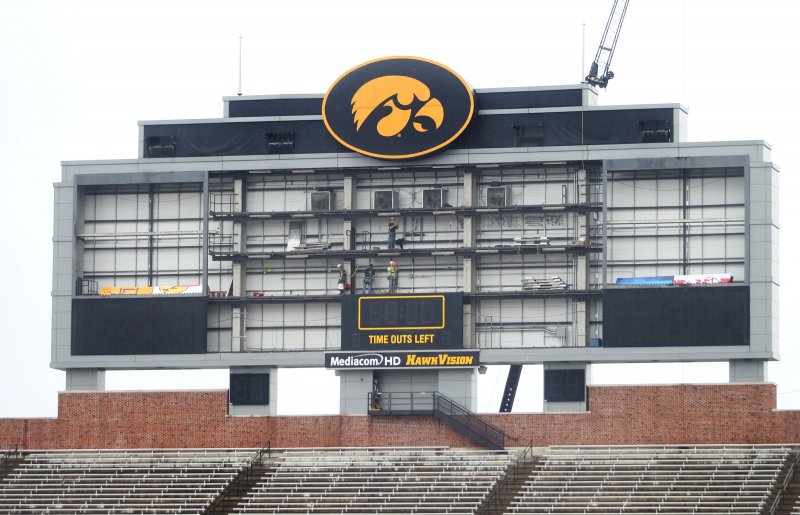UConn the Latest to Proceed with Scoreboard Replacement; Controversy Erupts at Penn State
/
When the State Bond Commission voted last week to approve $2.8 million for repairs to Rentschler Field in East Hartford, home of the newly rebranded Connecticut Huskies, it was said that about $1.67 million of that money will be used to replace scoreboards at the stadium.
The Hartford Courant reported that Kim Hart, the venue director for the Capital Regional Development Authority, which overssees the state-owned facility, said that scoreboards like the main one at Rentschler are typically replaced every 7 to 8 years. The main scoreboard at the Rent has been in place since the facility opened, a decade ago.
“It’s outlined its useful life and we’ve squeezed a few years out of it,” she was quoted as saying.
For sports fans accustomed to seeing stadium score boards in place for well over a decade at venues across the nation, the statement may have been jarring. But apparently, new technology is driving new scoreboard purchases at colleges coast-to-coast – and at costs considerably higher than in Connecticut.
boards in place for well over a decade at venues across the nation, the statement may have been jarring. But apparently, new technology is driving new scoreboard purchases at colleges coast-to-coast – and at costs considerably higher than in Connecticut.
In 2012, Ohio State University announced plans to install a larger high-definition scoreboard screen and improved audio equipment as part of $7 million in upgrades at its football stadium. The school said that the new 42-by-124-foot scoreboard at Ohio Stadium would replace an 11-year-old board that measures 30 feet by 90 feet, the CBS affiliate in Cleveland reported. When the new scoreboard debuted in August 2012, the school’s Lantern newspaper website reported that Don Patko, associate athletic director of Facilities Management, said the improvements were necessary and well worth the cost. “It was time for the video board to be replaced,” Patko said. “The usual life for a scoreboard is 12 to 15 years, and the last one was 12 years old.”
When Brigham Young University announced plans for a new scoreboard in 2012, to be paid by corporate donations, it was noted that “In 1996, a video wall was added to the south end zone and a matrix scoreboard to the north end zone. The north end zone scoreboard was updated in 2008 to include a small video board. The project will include state-of-art LED video walls in the north and south end zones, as well as LED ribbon boards across the top of both end zones.”
When North Carolina State University embarked on a fundraising drive for scoreboard replacement in 2011, Mark Steinkamp, a senior marketing director at Brookings, S.D.-based scoreboard provider Daktronics, told the StateFansNation that “large college football scoreboards can cost as much as several million dollars. Schools typically will replace them every seven to 10 years as new control and display technologies come along.”
Also in 2011, Penn State University launched a scoreboard replacement initiative. In a letter to prospective design professionals, University Architect David Zenghut pointed out that “The existing main end zone scoreboards were installed prior to the 2001 football season and operational maintenance is becoming increasingly challenging and costly. In addition, there have been dramatic advances in the audio/video technology of these products. In order to address the operational issue and enhance the game day spectator experience, we intend to replace both scoreboards with state-of-the-art, HD video boards that will complement the character of the stadium.”
Penn State assumed a construction budget of $5.5 million, according to the document. A year later, it was reported by StateCollege.com that the completion of the scoreboard replacement was pushed back from 2012 to 2014. And this week, with the projected cost now pegged at nearly $10 million, a local newspaper is calling for the project to be scaled back or scrapped.
The Centre Daily Times, in an editorial published on July 28, 2013, said “We question the decision to install a new scoreboard, approved at last week’s board of trustees meetings, … while costs tied to the Jerry Sandusky abuse scandal reached nearly $47 million. We wonder what the scoreboard decision says about the school’s priorities,” The newspaper continued “We’re surprised Penn State thought this was the right time to take an expensive step toward enhancing its athletics brand, the stated goal with the scorebo ard, given criticism hurled at the university during the Sandusky scandal. Those same trustees meetings approved yet-another tuition hike — this one nearly 4 percent ...”
ard, given criticism hurled at the university during the Sandusky scandal. Those same trustees meetings approved yet-another tuition hike — this one nearly 4 percent ...”
Just last month, progress in construction of a new scoreboard at the University of Iowa’s Kinnick Stadium was reported by the local ABC affiliate, which explained that “The video board/sound upgrades will be up and running for Iowa’s home football schedule this fall. The financing package the board approved for that Kinnick project totals $8 million, but they expect the total cost of everything will be $9 million because of the increase in bids on a portion of the project. The existing video walls, control room equipment and sound system at Kinnick are eight years old, UI officials told The Gazette. The company handling the project is Daktronics, Inc. As per usual, the Iowa athletics department will foot this bill using no tax or tuition cash.”
And earlier this year, Virginia Tech issued an RFP for a new scoreboard, which would be among the largest in college sports.





























